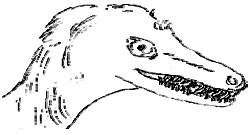Thinking about velociraptors
This task is about using evidence to make inferences about a dinosaur's life style.
The information in this task will help you think about velociraptors. Read it carefully, and then answer the questions.

All that scientists can truly know about dinosaurs is about their bones and teeth. Most often they do not even find whole skeletons. However, the bones can give scientists lots of clues about what dinosaurs might have looked like, and how they might have lived.
Scientists know from looking at animals in today's world that:
| Animals that eat plants are likely to have: |
Animals that eat meat are likely to have:
|
|
|
Scientists don't know what a velociraptor looked like. They might infer what a velociraptor looked like and what it did by:
- looking at fossils (usually bones and teeth);
- thinking about what they know about animals with similar features.
Scientists think that a velociraptor looked something like this.


